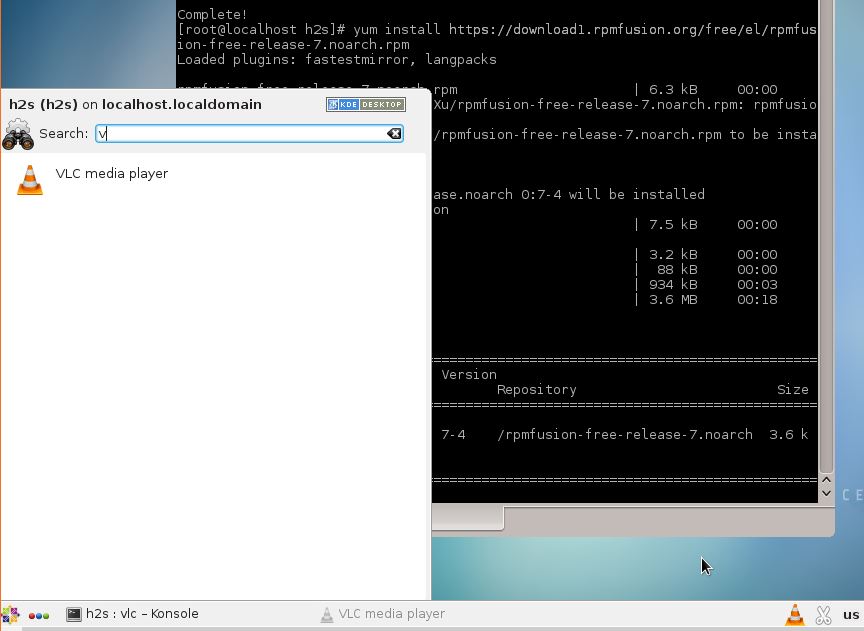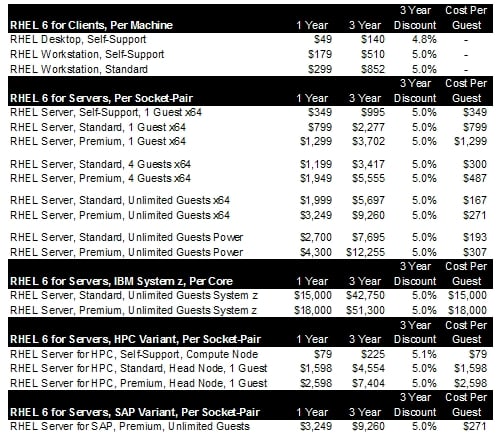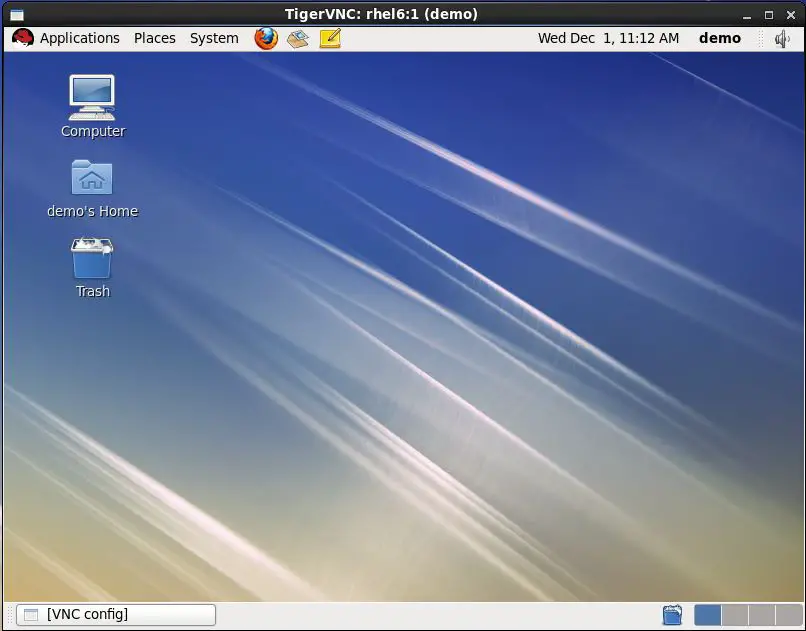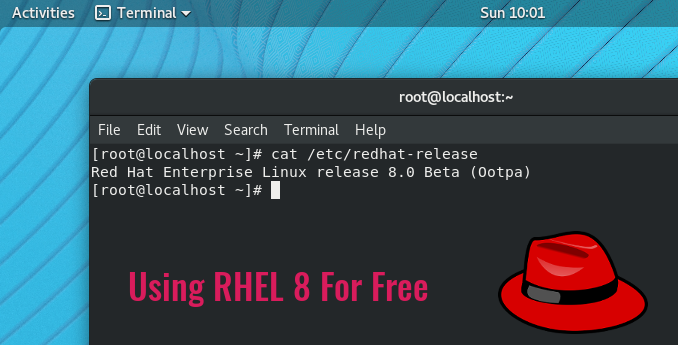| Home | Switchboard | Unix Administration | Red Hat | TCP/IP Networks | Neoliberalism | Toxic Managers |
| May the source be with you, but remember the KISS principle ;-) Skepticism and critical thinking is not panacea, but can help to understand the world better | ||||||
| News | X Window System | Softpanorama Bookshelf | Recommended Links | Architecture | Configuration |
| Exporting_display | 'Can't open display' Error | .Xresources | xrdb | Using xauth | Xdefaults |
| Fonts in X | X11 security | X display manager | XDMCP | vnc | vino |
| Installing X11 and Gnome Desktop in RHEL | Activating the gnome VNC vino-server from the command line | Cygwin/X | Xming | ||
| Troubleshooting | Diagnosing problems with remote X11 sessions via SSH | Too high refresh rate/ too high resolution problem | Tips | Humor | Etc |
Open your VirtualBox and click on the “New” icon. Assign a preferred name to your virtual machine. Install a Desktop Environment on CentOS 6 Minimal Install. December 24, 2013 David Lehman 8 Comments. After performing a base install of CentOS 6 using the minimal install CD, do the following to install a basic GNOME desktop environment: # yum groupinstall 'Desktop' 'Desktop Platform' 'X Window System' 'Fonts'.
- Installing the Graphical Window System (X.org-X11) and the Default Desktop Environment on CentOS 6 LinuxQuestions.org. Posted at 01:12 PM by gearge Updated at 02:29 PM by gearge Installing the Graphical Window System (X.org-X11) and the Default Desktop Environment on CentOS 6 Performing the default 'Minimal' install of CentOS 6 does not install the graphical subsystem.
- An icon used to represent a menu that can be toggled by interacting with this icon.
Introduction
X11 can be installed after you install minimal system. In RHEL 6 (and we will be talking about this version of RHEL) the need to install X11 occur when you forget to include X11 in the initial list of Anaconda packages. This problem arise due to change of default settings. In RHEL 6 when you install OS and don't use the customized option, you will not get the GUI.
You can install the missing packages using the command:
But that's only a start of your troubles:- Generally the idea of installing minimal system contradict the idea of installing gnome as this is a Christmas Tree type of applications ;-). You can't really have 'minimal system' AND 'gnome' as gnome is a bloated, badly debugged application. You probably need some minimalistic windows manager. 'Minimalist' doesn't mean it's too bare to be usable; just that it omits a lot of the bloat typical for Gnome.
So it is unclear what you are fighting for.
- In case when you accidentally installed system without X11 and need remote desktop functionality then it might be easier to reinstall then make everything working ;-)
Steps to restore X11
In any case you need several additional steps to get resemblance of the same system as constructed by Anaconda during the initial install with X11 (unless explicitly specified otherwise, all operations should be done from root account):
- Change the default runlevel to 5 (minimal install and any system without X11 default to levlel 3). You need to change it in /etc/inittab
- Enable vino (remote desktop). This is a tricky part:
- Login as user you want to have this functionality.
- If you can access to GUI console then you can enable it from System > Preferences > Remote Desktop for users the you want this functionality.
- In case you don't have access to GUI console, see Activating the gnome VNC vino-server from the command linefor some ideas.
Check the set of Gnome autostart applications (Gnome is a system with the system ;-) and ensure that vino-server is started by Gnome. Go to System -> Preferences -> Startup Applications sub menu. This is where you can enable, disable or add applications for Gnome auto start.
Add the line export DISPLAY=:0.0 to the /etc/profile. Execute it in your root session
Check if port (typically 5600) is open using the command
netstat -nl | grep 590[0-9]One problem that you will (at lease initially) encounter is that vino-server is not starting with gnome. This is due to absence of value of $DISPLAY variable. You can start it manually without rebooting using the following script. (IP of remote host is passed as parameter):
- Login as user you want to have this functionality.
Add your client to access list using xhost command, for example:
If you used the script for manual start of /usr/libexec/vino-server above xhost command was already executed.
- Try to connect from your Windows desktop/laptop using VMC client (for example TightVNC client).
Deinstallation and reinstallation as a troubleshooting tool
If your XX11 stop to be functional, For example a Gnome self-destruct (or you helped it ;-), deinstallation and reinstallation can be a more productive idea then trying to figure our the root caouse of the problem.
first verify the packages with to see what do you have now. This is and interesting exersize in its oqn and usully gives you some additional tips about extent of the damage.
Then try to install everything: that will take case about missing packagesNow you can reinstall
And then you need to update (just in case):
After those steps you need to restart the system specifying the runlevel 3 as the runlevel to boot to in /etc/initabFrom runlevel 3 you need manually start Gnome
If it is OK you need to stop Gnome using Ctrl-C and try switching to runlvel 5 using the command:
If this is OK, then you need to change back runlevel to which to boot to 5. But it might be not and then you need to specify the command
as a custom init script on level 3 (for example adding it to /etc/init.d/local).
Note: Sometimes Gnome runs OK when manually started from runlevel 3 but does not run if you specify runlevel 5 (This was, for example, the case when Red Hat screw patching of version 5.8 to 5.10). If you don't want to figure out why failure is ocuuring you can put start command in cron @start statement and forget about the problem. See Cron and Crontab commands

NEWS CONTENTS
- 20130718 : how to enable GUI in rhel 6 ( how to enable GUI in rhel 6, Jul 18, 2013 )
- 20130718 : [CentOS] Installing a gnome-desktop on CENTOS-6.3 following minimal system install. - Grokbase ( [CentOS] Installing a gnome-desktop on CENTOS-6.3 following minimal system install. - Grokbase, )
- 20130718 : Oct 5, 2012 at 9:31 am ( )
- 20130718 : Installing the Graphical Window System (X.org-X11) and the Default Desktop Environment on CentOS 6 ( Installing the Graphical Window System (X.org-X11) and the Default Desktop Environment on CentOS 6 , )
- 20130718 : Centos - Installing graphical X Window System (Boot Options, startx from command line) ( Centos - Installing graphical X Window System (Boot Options, startx from command line), )
Old News ;-)
| Switchboard | |||||
| Latest | |||||
| Past week | |||||
| Past month | |||||
[Jul 18, 2013]how to enable GUI in rhel 6
02-03-2011, 03:11 PM #3
John VV
Guru
Registered: Aug 2005
Posts: 9,916
Rep: servers normally DO NOT have a gui, there is no monitor attached to the server / blade center
if this is a desktop install of RHEL6.0 did you buy the license
http://www.redhat.com/rhel/benefits/
http://www.redhat.com/rhel/desktop/
also did you install gnome ????
In RHEL 6 when u install OS & don't use the customized option so you will not get the GUI
if you select that option at the time of OS installation you will select the kde of Gnome etc
Following steps can resolve your prob
Quote:
yum groupinstall 'X Window System' 'GNOME Desktop Environment'

need KDE
yum groupinstall 'X Window System' KDE
need XFCE
yum groupinstall 'X Window System' XFCE
Rhel 6 Desktop Download Iso
Thanks
dkpant
[CentOS] Installing a gnome-desktop on CENTOS-6.3 following minimal system install. - Grokbase
Nux!Oct 5, 2012 at 9:31 am ⇧
On 05.10.2012 14:05, James B. Byrne wrote:
So what is it that I am missing? What other step is required to get
my 'normal' gnome desktop with the utilities ans such displayed in
the
title bar?
Try:
Btw, you can't really have 'minimal' AND 'gnome' ... :-)
Nux!
www.nux.ro
Installing the Graphical Window System (X.org-X11) and the Default Desktop Environment on CentOS 6
LinuxQuestions.orgPosted 09-06-2011 at 01:12 PM by gearge
Updated 11-26-2011 at 02:29 PM by gearge Installing the Graphical Window System (X.org-X11) and the Default Desktop Environment on CentOS 6
Performing the default 'Minimal' install of CentOS 6 does not install the graphical subsystem (the X.org server) and the desktop environment (e.g. GNOME or KDE). Such OS install is nice for building an optimal system from scratch, setting up a headless server (no monitor, keyboard and mouse) and other purposes; but for one reason or another, you may still require a graphical user interface (GUI). This tutorial will show you how to install and start the graphical window system and the desktop environment of your choice.
To achieve the task, you will need to install the following package groups (groups of packages combined for a common purpose): 'X Window System', 'Desktop', 'Fonts' and 'General Purpose Desktop' (last two are optional). This will install about 500 additional packages on your system (~250MB download, or you may use the available OS installation DVD to retrieve packages).
 Code: (Please enter this as is - package group names as well as package names are case sensitive).
Code: (Please enter this as is - package group names as well as package names are case sensitive).Previous versions of RHEL and its derivatives provided a package group called 'GNOME Desktop Environment', that was sufficient for a general purpose GNOME desktop. Currently, package group 'Desktop' installs all critical components of GNOME, including gdm (the GNOME Display Manager), plus a few additional packages; enough to provide a minimalist GNOME desktop with mouse support, a graphical file manager, copy/paste functionality and the luxurious GNOME Terminal emulator - maybe just what you need. Thus, installing the 'General Purpose Desktop' package group is optional, but will help you mimic the system you would probably get if you where to include the default graphical desktop during OS install. Alternatively, you can chose a single package group 'KDE Desktop', for a general purpose KDE Software Compilation.
It is generally recommended to install the 'Fonts' package group to improve usability of the GUI, no matter what desktop environment you choose to install.
You may view the complete list of available package groups by issuing:
Code:
You may review the contents of each package group by entering:Code:
To boot directly into GUI, you will need to manually change the runlevel of the system from 3 (full multiuser environment with networking) to 5 (the same as mode 3 + X11), by changing the line 'id:3:initdefault:' to 'id:5:initdefault:' in /etc/inittab file. Or you can manually start X.org from console, by entering 'startx' (without quotes).Upon installation and subsequent reboot, you will be presented with the 'Setup Agent' interface (even if you choose to stay in runlevel 3, you will see the text user interface of this tool - hence, the options provided will be different from the graphical variant). This is due to package 'firstboot' being automatically installed by the 'X Window System' package group and can be a handy way to setup a freshly installed system. All steps in 'Setup Agent' are optional, so you can just skim through them, skipping any. Though, creating a new normal user on a freshly installed system is done best through this graphical tool, as it helps automatically create the new user and associate it with groups (such as the 'video' group) appropriate for everyday use in a GUI environment . So, for the purpose of this tutorial, I would advice not skipping the user creation step.
Centos - Installing graphical X Window System (Boot Options, startx from command line)
Nov 13, 2012 | leerraum blog
Installing GUI
Installing the Graphical Window System (X.org-X11) and the Default Desktop Environment on CentOS 6Performing the default 'Minimal' install of CentOS 6 does not install the graphical subsystem (the X.org server) and the desktop environment (e.g. GNOME or KDE). Such OS install is nice for building an optimal system from scratch, setting up a headless server (no monitor, keyboard and mouse) and other purposes; but for one reason or another, you may still require a graphical user interface (GUI). This tutorial will show you how to install and start the graphical window system and the desktop environment of your choice.
To achieve the task, you will need to install the following package groups (groups of packages combined for a common purpose): 'X Window System', 'Desktop', 'Fonts' and 'General Purpose Desktop' (last two are optional). This will install about 500 additional packages on your system (~250MB download, or you may use the available OS installation DVD to retrieve packages).
Code:
(Please enter this as is - package group names as well as package names are case sensitive).Previous versions of RHEL and its derivatives provided a package group called 'GNOME Desktop Environment', that was sufficient for a general purpose GNOME desktop. Currently, package group 'Desktop' installs all critical components of GNOME, including gdm (the GNOME Display Manager), plus a few additional packages; enough to provide a minimalist GNOME desktop with mouse support, a graphical file manager, copy/paste functionality and the luxurious GNOME Terminal emulator - maybe just what you need. Thus, installing the 'General Purpose Desktop' package group is optional, but will help you mimic the system you would probably get if you where to include the default graphical desktop during OS install. Alternatively, you can chose a single package group 'KDE Desktop', for a general purpose KDE Software Compilation.
It is generally recommended to install the 'Fonts' package group to improve usability of the GUI, no matter what desktop environment you choose to install.
You may view the complete list of available package groups by issuing:
Code:
You may review the contents of each package group by entering:Code:
Enabling booting into GUI - start GUI from command line
To boot directly into GUI, you will need to manually change the runlevel of the system from 3 (full multiuser environment with networking) to 5 (the same as mode 3 + X11), by changing the line 'id:3:initdefault:' to 'id:5:initdefault:' in /etc/inittab file. Or you can manually start X.org from console, by entering 'startx' (without quotes).Upon installation and subsequent reboot, you will be presented with the 'Setup Agent' interface (even if you choose to stay in runlevel 3, you will see the text user interface of this tool - hence, the options provided will be different from the graphical variant). This is due to package 'firstboot' being automatically installed by the 'X Window System' package group and can be a handy way to setup a freshly installed system. All steps in 'Setup Agent' are optional, so you can just skim through them, skipping any. Though, creating a new normal user on a freshly installed system is done best through this graphical tool, as it helps automatically create the new user and associate it with groups (such as the 'video' group) appropriate for everyday use in a GUI environment .
If you have installed the X Window System but are not seeing a graphical desktop environment once you log into your Red Hat Enterprise Linux system, you can start the X Window System graphical interface using the command startx.
Note, however, that this is just a one-time fix and does not change the log in process for future log ins.
To set up your system so that you can log in at a graphical login screen, you must edit one file,/etc/inittab, by changing just one number in the runlevel section. When you are finished, reboot the computer. The next time you log in, you are presented with a graphical login prompt.Open a shell prompt. If you are in your user account, become root by typing the su command.
gedit /etc/inittab to edit the file with gedit. The file /etc/inittab opens. Within the first screen, a section of the file which looks like the following appears: To change from a console to a graphical login, you should change the number in the lineid:3:initdefault: from a 3 to a 5.
Recommended Links
Google matched content |
Softpanorama Recommended
Top articles
Sites
General info
Etc
Society
Groupthink :Two Party System as Polyarchy : Corruption of Regulators :Bureaucracies :Understanding Micromanagers and Control Freaks : Toxic Managers : Harvard Mafia :Diplomatic Communication : Surviving a Bad Performance Review : Insufficient Retirement Funds as Immanent Problem of Neoliberal Regime : PseudoScience :Who Rules America :Neoliberalism : The Iron Law of Oligarchy : Libertarian Philosophy
Quotes
War and Peace: Skeptical Finance : John Kenneth Galbraith :Talleyrand :Oscar Wilde :Otto Von Bismarck :Keynes :George Carlin :Skeptics :Propaganda : SE quotes : Language Design and Programming Quotes :Random IT-related quotes : Somerset Maugham :Marcus Aurelius :Kurt Vonnegut :Eric Hoffer :Winston Churchill :Napoleon Bonaparte :Ambrose Bierce : Bernard Shaw : Mark Twain Quotes
Bulletin:
Vol 25, No.12 (December, 2013) Rational Fools vs. Efficient Crooks The efficient markets hypothesis :Political Skeptic Bulletin, 2013 :Unemployment Bulletin, 2010 : Vol 23, No.10 (October, 2011) An observation about corporate security departments :Slightly Skeptical Euromaydan Chronicles, June 2014 :Greenspan legacy bulletin, 2008 :Vol 25, No.10 (October, 2013) Cryptolocker Trojan (Win32/Crilock.A) :Vol 25, No.08 (August, 2013) Cloud providers as intelligence collection hubs : Financial Humor Bulletin, 2010 :Inequality Bulletin, 2009 :Financial Humor Bulletin, 2008 :Copyleft Problems Bulletin, 2004 :Financial Humor Bulletin, 2011 :Energy Bulletin, 2010 : Malware Protection Bulletin, 2010 : Vol 26, No.1 (January, 2013) Object-Oriented Cult :Political Skeptic Bulletin, 2011 :Vol 23, No.11 (November, 2011) Softpanorama classification of sysadmin horror stories : Vol 25, No.05 (May, 2013) Corporate bullshit as a communication method : Vol 25, No.06 (June, 2013) A Note on the Relationship of Brooks Law and Conway Law
History:
Fifty glorious years (1950-2000): the triumph of the US computer engineering :Donald Knuth : TAoCP and its Influence of Computer Science : Richard Stallman : Linus Torvalds :Larry Wall :John K. Ousterhout : CTSS : Multix OSUnix History : Unix shell history :VI editor :History of pipes concept :Solaris : MS DOS : Programming Languages History :PL/1 : Simula 67 :C :History of GCC development : Scripting Languages :Perl history :OS History : Mail :DNS : SSH : CPU Instruction Sets :SPARC systems 1987-2006 :Norton Commander :Norton Utilities :Norton Ghost :Frontpage history :Malware Defense History :GNU Screen : OSS early history
Classic books:
The Peter Principle : Parkinson Law : 1984 :The Mythical Man-Month : How to Solve It by George Polya :The Art of Computer Programming :The Elements of Programming Style :The Unix Hater’s Handbook :The Jargon file :The True Believer :Programming Pearls :The Good Soldier Svejk : The Power Elite
Most popular humor pages:
Manifest of the Softpanorama IT Slacker Society :Ten Commandments of the IT Slackers Society : Computer Humor Collection : BSD Logo Story :The Cuckoo's Egg :IT Slang : C++ Humor : ARE YOU A BBS ADDICT? :The Perl Purity Test :Object oriented programmers of all nations : Financial Humor :Financial Humor Bulletin, 2008 : Financial Humor Bulletin, 2010 : The Most Comprehensive Collection of Editor-related Humor : Programming Language Humor :Goldman Sachs related humor :Greenspan humor : C Humor :Scripting Humor :Real Programmers Humor :Web Humor : GPL-related Humor : OFM Humor :Politically Incorrect Humor :IDS Humor : 'Linux Sucks' Humor : Russian Musical Humor : Best Russian Programmer Humor : Microsoft plans to buy Catholic Church : Richard Stallman Related Humor :Admin Humor : Perl-related Humor : Linus Torvalds Related humor : PseudoScience Related Humor :Networking Humor :Shell Humor :Financial Humor Bulletin, 2011 : Financial Humor Bulletin, 2012 :Financial Humor Bulletin, 2013 : Java Humor : Software Engineering Humor : Sun Solaris Related Humor :Education Humor : IBM Humor : Assembler-related Humor :VIM Humor : Computer Viruses Humor : Bright tomorrow is rescheduled to a day after tomorrow : Classic Computer Humor
The Last but not LeastTechnology is dominated by two types of people: those who understand what they do not manage and those who manage what they do not understand ~Archibald Putt. Ph.D
Copyright © 1996-2020 by Softpanorama Society. www.softpanorama.org was initially created as a service to the (now defunct) UN Sustainable Development Networking Programme (SDNP) in the author free time and without any remuneration. This document is an industrial compilation designed and created exclusively for educational use and is distributed under the Softpanorama Content License. Original materials copyright belong to respective owners. Quotes are made for educational purposes only in compliance with the fair use doctrine.
FAIR USE NOTICEThis site contains copyrighted material the use of which has not always been specifically authorized by the copyright owner. We are making such material available to advance understanding of computer science, IT technology, economic, scientific, and social issues. We believe this constitutes a 'fair use' of any such copyrighted material as provided by section 107 of the US Copyright Law according to which such material can be distributed without profit exclusively for research and educational purposes.
This is a Spartan WHYFF (We Help You For Free) site written by people for whom English is not a native language. Grammar and spelling errors should be expected. The site contain some broken links as it develops like a living tree...
| You can use PayPal to make a contribution, supporting development of this site and speed up access. In case softpanorama.org is down you can use the at softpanorama.info |
Disclaimer:
The statements, views and opinions presented on this web page are those of the author (or referenced source) and are not endorsed by, nor do they necessarily reflect, the opinions of the author present and former employers, SDNP or any other organization the author may be associated with.We do not warrant the correctness of the information provided or its fitness for any purpose. The site uses AdSense so you need to be aware of Google privacy policy. You you do not want to be tracked by Google please disable Javascript for this site. This site is perfectly usable without Javascript.
Last modified:July 28, 2019
If you want a Lightweight Desktop Environment for your CentOS/RHEL then Xfce is your ideal candidate. Unlike Gnome and KDE, Xfce takes very little resource of your system.
Step 1: Download the install packages from EPEL repository
– First install the wget package with following command
[code language=”js”]# yum install wget[/code]
– Download and install epel repo with following commands:
For 64bit Centos system
[code language=”js”]
# wget http://download.fedoraproject.org/pub/epel/6/x86_64/epel-release-6-8.noarch.rpm
# rpm -ivh epel-release-6-8.noarch.rpm
[/code]
For 32bit Centos system

[code language=”js”]
# wget http://download.fedoraproject.org/pub/epel/6/i386/epel-release-6-8.noarch.rpm
# rpm -ivh epel-release-6-8.noarch.rpm
[/code]
Step 2: Install Xfce and additional packages
– Run following commands:
[code language=”js”]# yum -y groupinstall Xfce[/code]
[code language=”js”]# yum -y install xorg-x11-fonts-Type1 xorg-x11-fonts-misc[/code]
Step 3: Start Xfce desktop
To start Xfce after install, run any of the following commands:
[code language=”js”]# /sbin/telinit 5[/code]
or
[code language=”js”]startxfce4[/code]
Note:
– If you installed Xfce on top of Gnome and/or KDE, the default desktop would be Gnome. To log into Xfce desktop from Gnome login screen, simply click on the username, at the bottom of the screen click the Session drop-down box and select Xfce session
– You can also set Xfce as default desktop screen by following steps outlined here for KDE
Redhat 6 Download Free
Feel free to share your install experience 🙂
Redhat 6.10 Download
Please enable JavaScript to view the comments powered by Disqus.comments powered byRhel 7.6 Download
Disqus